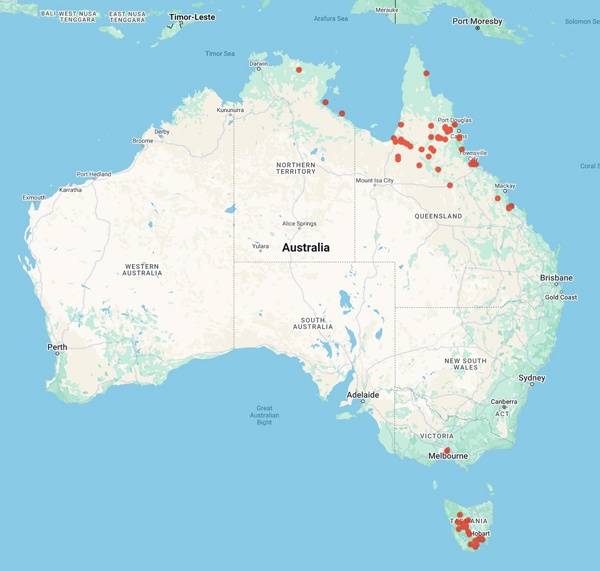
Council of Heads of Australasian Herbaria
Australian National Herbarium
Biographical Notes
 |
Council of Heads of Australasian Herbaria |
Born 3 Mar. 1848, Cornwall, England; died 13 June 1931, Townsville, Queensland.
His parents, Thomas (Allingham) Allen
Gulliver, aged 48, and his wife Sarah Jane Gulliver
(née Day), aged c. 28, arrived in
Melbourne on board S.V. Startled Fawn from Deal,
England on 31 October 1856 with their four children.
Ship manifests and immigration documents listed four
accompanying children: Thomas Allen Gulliver, aged
eight years, Benjamin John Gulliver, aged five, Sarah
Anne Gulliver, aged three and George (James) Gulliver,
aged 21, Thomas' son by a previous marriage.
After arrival in Melbourne, the family went to Bendigo
where Thomas (Snr) tried his luck in the goldfields and
later was employed at a station on Campaspe River
before settling in Melbourne in 1860.
Thomas (Snr) took
employment as a gardener when the Melbourne
Botanic Gardens and adjacent gardens were under
the directorship of Victorian government botanist
Ferdinand von Mueller.
Thomas (jnr) was employed as a gardener in the Melbourne
Botanic Gardens and the Government House reserve
between 1863 and 1870.
There are records that both he and
Benjamin made "contributions of museum plants [ie, herbarium specimens]" in 1869.
His brother Benjamin moved to
Tasmania in late 1870 or 1871 and was engaged in seed
collecting/marketing and fruit cropping. He specialised in the
collecting and marketing of Eucalyptus seeds. In a report of the May 1876 monthly meeting of members of the Royal Society of Tasmania there was
reference to the "Brothers Gulliver" having collected
seed of species of Eucalyptus from Mount Wellington, so presumably Thomas was also there.
While Benjamin (and possibly Susannah) remained
in the south, Thomas (jnr), in 1873, took a position
in Queensland as a telegraph line repairer after the
completion of the telegraph line from Cardwell to the
mouth of Norman River in 1872.
The route
of the Gulf of Carpentaria line, in a westerly direction,
was Cardwell, Taylors Creek, Cashmere, Mineral
Springs, Junction Creek, Eva Creek, Ada Creek,
Etheridge, Gilbert River, Wooleys Lagoon, Carron
Creek, Francis's Lagoon, Rocky Creek, Normanton
and Sandy Point. Some of these place names were
used by Thomas on his field collection labels.
In 1875 Thomas took on
the role of telegraph station master at Normanton,
then at Thornborough from 1877-27 through to early
1882. On 1 July 1882, he was appointed manager
of the telegraph office in Townsville, and in 1896 as
Officer-in-Charge. In 1904, he took a
position in Brisbane as assistant manager of telegraphs,
but returned to Townsville in 1905 to be postmaster.
He remained at Townsville post office until he resigned
in April 1911 and retired in May 1913.
Concurrent with his roles in the telegraph and postal
department, Thomas pursued interests in horticulture
and experimental agriculture. He developed a 40
acre (16 hectare) property at Roseneath [sometimes
incorrectly referred to as Rosemead] to the west of
Townsville, experimenting with tropical crops and
breeding a number of award-winning mango cultivars.
He was a regular contributor of natural history articles
to the Queenslander and the Brisbane Courier [1878-
1882], mostly under the pseudonym of 'Nettapus'.
Mueller (1885) indicated that Thomas was
instrumental in acquiring specimens collected in New
Guinea in 1884 by the naturalist Erik Gustaf Edelfelt.
Mueller wrote that Edelfelt was "an emissary of Thomas
Gulliver, Esq., F.L.S., of Townsville, who made large
monetary sacrifices, to obtain thus some new scientific
material from New Guinea". To commemorate Thomas'
contribution in this regard, Mueller (1885) named a
species of New Guinea oak as Quercus gulliveri F.Muell.
[= Lithocarpus celebicus (Miq.) Rehder].
In 1885, Mueller, William Woolls and Robert
Fitzgerald, all then fellows of the Linnean Society,
London, jointly nominated Thomas as a fellow of the
society. The letter of nomination stated: "We the
undersigned propose Thomas Gulliver Esq. Director
of the Telegraph Department, Forrestville Qld. for the
honor of the fellowship of the Linnean Society, he being
well deserving of this distinction by his zealous exertions
for the furtherance of zoology and botany in New
Guinea and Queensland".
By the late 1880s, Benjamin, in collaboration with
Thomas and Susannah, and some of his children,
had formed 'Acacia Vale Gardens and Nursery' into
a flourishing family business.
Benjamin and Thomas made a
small number of botanical collections in the vicinity of
Townsville (Cleveland Bay, Magnetic Island) as well as
a few other places in north-east Queensland.
Read:
A much more detailed account of the Gulliver family collecting, including birds, shells, etc in:
John Leslie Dowe & Philip S. Short,
"The Gullivers' travels: Thomas Allen Gulliver (1848-1931), Benjamin
John Gulliver (1851-1938) and Susannah Gulliver (1857-1938): their
contribution to Australian natural history and horticulture"
Swainsona 38: 4572 (2024)
https://data.environment.sa.gov.au/Content/Publications/JABG38P045_Dowe.pdf
Source: Extracted from:
John Leslie Dowe & Philip S. Short,
"The Gullivers' travels: Thomas Allen Gulliver (1848-1931), Benjamin John Gulliver (1851-1938) and Susannah Gulliver (1857-1938): their contribution to Australian natural history and horticulture"
Swainsona 38: 4572 (2024)
Portrait Photo: None known
Data from 824 specimens
